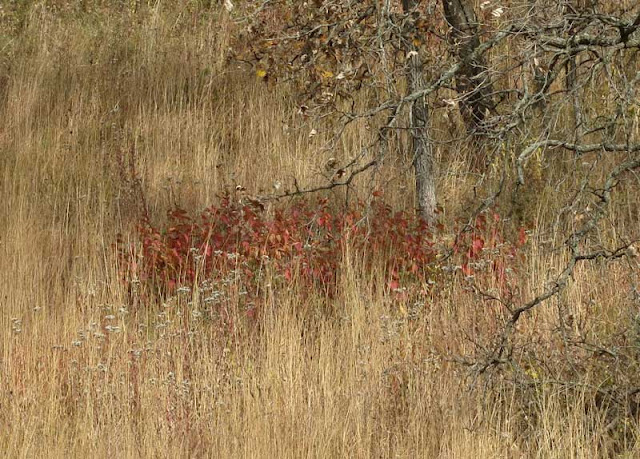Seeing green this time of year is bad!
By late October most of the native species have either turned color or lost their leaves. Anything green now is almost certainly nonnative (bad). This is a great time to survey for invasive brush which, because they are still green, really stand out.
Buckthorn and other nonnative shrubs: Buckthorn, in particular, really stand outs, as the photo shows. Note that this buckthorn plant is a new vagrant in a tall grass prairie that has been burned annually for the past 15 years. This shows two things: 1) Fire will not eradicate buckthorn; 2) The buckthorn rootstock has a long persistence, since this plant is new in 2015 in an area that had been cleared of buckthorn in 1998!
However, this is probably not a good time to use a foliar spray on this bush. At this late in the season, one can't be certain that the herbicide will still be translocated to the roots (which is essential if this bush is to be eradicated). However, basal bark with 20% Garlon 4 in bark oil will work 12 months of the year, and this is how Amanda dealt with this plant.
Nonnative herbaceous perennials still green: Lots of nonnative herbaceous perennials retain their green color long after native species have senesced. This includes such culprits as garlic mustard, hedge parsley, sweet clover (1st year plants), mullein, burdock, catnip, and motherwort. This is an excellent time to foliar spray these plants with 2-4% glyphosate. The rule is that only green leaves will take up glyphosate and translocate it to the roots. Since most native species have senesced, there is no danger of peripheral damage.
This time of year, all of our Solo backpack sprayers have been put away for the winter, but the Solo 2 gallon hand-held sprayer was still available and worked well on this small area. It took about 15 minutes to deal with this patch. A nearby patch of catnip was also treated.
 |
| Buckthorn bush in the midst of the S slope prairie |
However, this is probably not a good time to use a foliar spray on this bush. At this late in the season, one can't be certain that the herbicide will still be translocated to the roots (which is essential if this bush is to be eradicated). However, basal bark with 20% Garlon 4 in bark oil will work 12 months of the year, and this is how Amanda dealt with this plant.
Nonnative herbaceous perennials still green: Lots of nonnative herbaceous perennials retain their green color long after native species have senesced. This includes such culprits as garlic mustard, hedge parsley, sweet clover (1st year plants), mullein, burdock, catnip, and motherwort. This is an excellent time to foliar spray these plants with 2-4% glyphosate. The rule is that only green leaves will take up glyphosate and translocate it to the roots. Since most native species have senesced, there is no danger of peripheral damage.
This time of year, all of our Solo backpack sprayers have been put away for the winter, but the Solo 2 gallon hand-held sprayer was still available and worked well on this small area. It took about 15 minutes to deal with this patch. A nearby patch of catnip was also treated.










